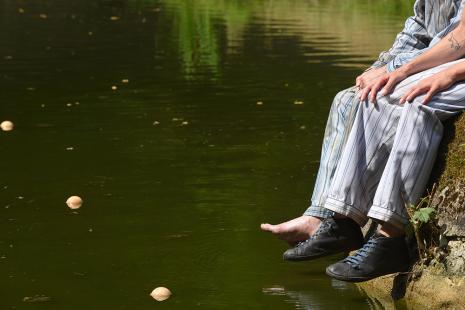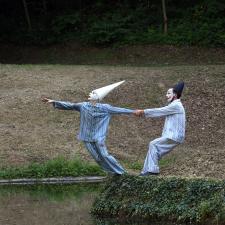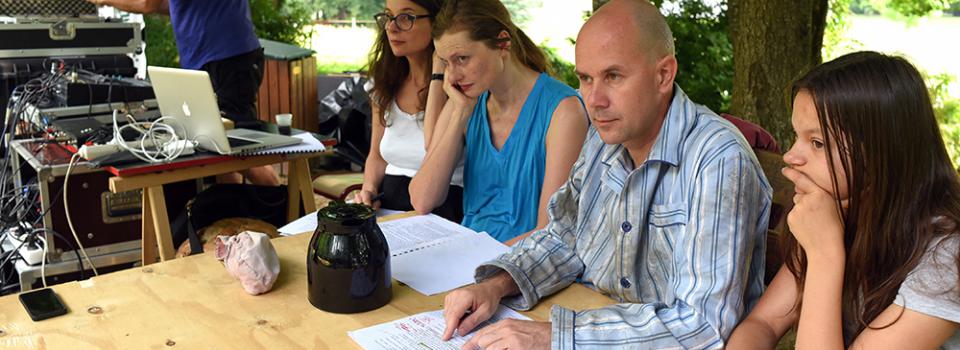
THE CLOWN OF THE BOULDER # 1
The origins of the origins
Why did we gather, on Monday 12 June 2017, in the magnificent park of Pôle Cirque de Nexon, the beating heart of circus arts hidden in the green Limousin countryside? Spring is nearing its end and it is hot, very hot, a heatwave that not even the closeness of water, around which we have settled, alleviates.
The Clown of the Boulderand its multiple origins are the reason why we are gathered here for a few days. The show will come to life in this park during the La Route du Sirque 2017festival, on Friday 25 and Saturday 26 August 2017.
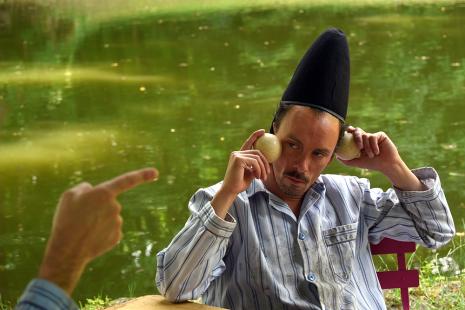
The artist as a dung beetle: a poet in action
Jean Lambert-wild is a poet whose language is made of the exotic varieties of wood that lined the flamboyant paths of his childhood, which he spent on the island of Réunion. “A clown is a poet in action”, said Henry Miller: this is indeed what is at stake here: writing as a physical act as well as the body activated by language. The Talker Clownshows the pattern of such an adventure through three different moments, three different texts.
There was first The Clown of the Swamps, the first instalment written and performed in Singapore with the complicity of Marc Goldberg. That text takes the audience into the marshes of Lambert-wild’s childhood in Réunion. They are a muddy and unhospitable stretch, but they’re also as voluptuous as a baby’s bath. This is where Lambert-wild’s language was formed; it now overflows with the thousand aromas of these humid nooks.
Then there will be The Clown of the Stream. From the swamps, thin trickles of water escape and become streams. They progress and become the clown’s entrances that will untie the poetic action contained in language. This text, and this game, is yet to come. But it must happen soon, because the clown doesn’t wait. He waits for no one, he refuses to wait. To make this piece we will meet next season, in Limoges and in Singapore once again.
Finally, The Clown of the Boulderoffers a third perspective. It also says in another voice what this poet in action’s origins and paths are, as he is taken in through the imaginary bestiary of a coprophilous Sisyphus. There, Albert Camus, Jean-Henri Fabre, a dung rolling sacred scarab and many other mandibular poets and philosophers come together and dialogue with each other. In so doing, they tell the fable of the artist-dung beetle, a white clown that first hurtles down the slopes of the Reunion’s craters before rolling his ball of dung to the centre of a circus ring.
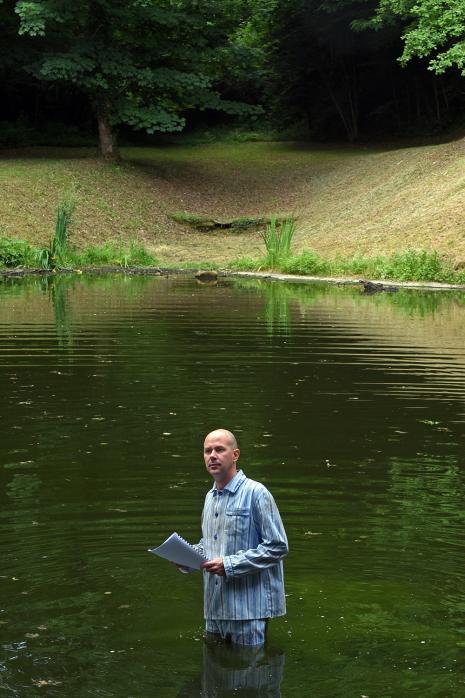
Chestnut spread
Another starting point of The Clown of the Boulderis the encounter between two artists who respect and esteem one another. Jean Lambert-wild and Martin Palisse are both artists and both the directors of producing venues in the Limousin territory: Théâtre de l’Union – Centre Dramatique National and Le Sirque – Pôle National des arts du Cirque de Nexon.
They have in common bodies with a similar resonance: quick, acute, cutting, always in movement. They share a way of looking, upright and alert, and the same quest for perspective. They are two bodies who like chestnut spread, in a tube or in a pot, everywhere and anywhere. Two bodies who are furiously alive, ready to tame language, whether it be physical or written, as long that it is able to create fury, beauty, tears, laughter, ambiguity, the suspension of time, poetry.
Jean Lambert-wild and Martin Palisse have decided to work together and create a short and intense artistic endeavour, with no constraints or major stakes in the way it is produced. With this artistic encounter, we will see what can come out of the conjunction of these two artists-dung beetles’ bodies, one a juggler and a poet whose action is aerial, the other a white clown with thundering actions.
